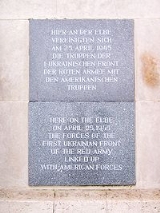
Line of contact
Encyclopedia

World War II
World War II, or the Second World War , was a global conflict lasting from 1939 to 1945, involving most of the world's nations—including all of the great powers—eventually forming two opposing military alliances: the Allies and the Axis...
. This contact began with the first meeting between Soviet and American forces at Torgau
Torgau
Torgau is a town on the banks of the Elbe in northwestern Saxony, Germany. It is the capital of the district Nordsachsen.Outside Germany, the town is most well known as the place where during the Second World War, United States Army forces coming from the west met with forces of the Soviet Union...
, near the Elbe
Elbe
The Elbe is one of the major rivers of Central Europe. It rises in the Krkonoše Mountains of the northwestern Czech Republic before traversing much of Bohemia , then Germany and flowing into the North Sea at Cuxhaven, 110 km northwest of Hamburg...
river on Elbe Day
Elbe Day
Elbe Day, April 25, 1945, was the date Soviet and American troops met at the River Elbe, near Torgau in Germany, marking an important step toward the end of the World War II in Europe. The first contact was made between patrols near Strehla, when First Lieutenant Albert Kotzebue crossed the River...
, April 25, 1945. The line continued to form as American, British and Soviet forces took control of, or defeated, Nazi forces, up until about the time of the May 8 unconditional surrender of Germany. This line of contact did not conform to the agreed-upon occupation zones, as stipulated in the Yalta Conference
Yalta Conference
The Yalta Conference, sometimes called the Crimea Conference and codenamed the Argonaut Conference, held February 4–11, 1945, was the wartime meeting of the heads of government of the United States, the United Kingdom, and the Soviet Union, represented by President Franklin D...
. Rather, it was simply the place where the two armies met each other. The American and British forces had actually gone far beyond the Yalta agreement boundaries, in some cases up to two hundred miles past, going deep into the states
States of Germany
Germany is made up of sixteen which are partly sovereign constituent states of the Federal Republic of Germany. Land literally translates as "country", and constitutionally speaking, they are constituent countries...
of Mecklenburg, Saxony-Anhalt
Saxony-Anhalt
Saxony-Anhalt is a landlocked state of Germany. Its capital is Magdeburg and it is surrounded by the German states of Lower Saxony, Brandenburg, Saxony, and Thuringia.Saxony-Anhalt covers an area of...
, Saxony
Saxony
The Free State of Saxony is a landlocked state of Germany, contingent with Brandenburg, Saxony Anhalt, Thuringia, Bavaria, the Czech Republic and Poland. It is the tenth-largest German state in area, with of Germany's sixteen states....
, as well as Brandenburg
Brandenburg
Brandenburg is one of the sixteen federal-states of Germany. It lies in the east of the country and is one of the new federal states that were re-created in 1990 upon the reunification of the former West Germany and East Germany. The capital is Potsdam...
. The city of Leipzig
Leipzig
Leipzig Leipzig has always been a trade city, situated during the time of the Holy Roman Empire at the intersection of the Via Regia and Via Imperii, two important trade routes. At one time, Leipzig was one of the major European centres of learning and culture in fields such as music and publishing...
, in Saxony, was probably the largest of the cities captured by the Americans that were inside the areas to be later passed to the Soviets. The land of Thuringia was completely occupied by American forces.
U.S. forces held onto these gains until July 1945, when under orders from President Harry S. Truman
Harry S. Truman
Harry S. Truman was the 33rd President of the United States . As President Franklin D. Roosevelt's third vice president and the 34th Vice President of the United States , he succeeded to the presidency on April 12, 1945, when President Roosevelt died less than three months after beginning his...
, and against the advice of British Prime Minister Winston Churchill
Winston Churchill
Sir Winston Leonard Spencer-Churchill, was a predominantly Conservative British politician and statesman known for his leadership of the United Kingdom during the Second World War. He is widely regarded as one of the greatest wartime leaders of the century and served as Prime Minister twice...
the U.S. forces withdrew to the Yalta agreement boundaries dividing Germany into occupation zones. What this meant was that many villages and cities initially occupied by American troops, and held by them for two months, now saw these forces leave and Soviet troops come in. For many Germans in the affected areas, already ravaged by six years of war, this was a bitter pill to swallow. The consolation was that by this time the marauding and pillaging Soviet shock troops that had devastated places such as Berlin, in the aftermath of the battle of Berlin
Battle of Berlin
The Battle of Berlin, designated the Berlin Strategic Offensive Operation by the Soviet Union, was the final major offensive of the European Theatre of World War II....
, would be replaced by comparatively sedate Soviet forces now that hostilities were over. It is worth noting that the Soviet Union may not have allowed American and British forces into Berlin, which was completely under their control, if the U.S. had not honored the Yalta agreement boundaries.
Line of Contact can also refer to the demarcation between any two armies, or more. This contact can be between belligerent or between allied armies.
Multimedia
- CBC Archives CBC Radio reports on the Russian and American meeting at Torgau on May 1 1945.

